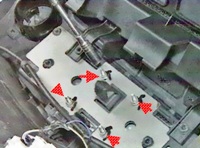To prevent breakage of the contact disc under the steering wheel, observe the following instructions:
- - before disconnecting the steering shaft from the steering mechanism, be sure to block the steering wheel with a special tool with the wheels set to the straight ahead position, and the steering wheel must remain locked during the entire time of work;
- - if in any doubt about the correct centering of the contact plate, remove the steering wheel and center the contact plate.
Remove
Put the car on a two-post lift.
Remove the top engine covers.
Disconnect the wires from the battery terminals, starting with the negative terminal.
Remove:
- – air intake pipe;
- - battery;
- - battery shelf;
- - injection computer with bracket;
- - intake air duct;
- – wiring harness attachments.
Remove the ball end of the multifunction switch cable using the tool and the cable itself.
Disconnect the wire block from the speed sensor, the wire block, releasing the movable part of the connector and unscrew the bolts securing the modular connector bracket.
Protect the connector by placing it in a waterproof plastic bag.

Remove the engine speed sensor (fig. 1 and 2).

Clamp the hoses with clamps.
Disconnect the hoses from the cooler.
Remove the wiring harness from the transmission.

Remove the two starter mounting bolts and remove the engine undertray (fig. 3).
Drain the gearbox oil.
Remove the wheels and fender liner.
Disconnect the wires from the ABS sensors and the wires from the xenon headlight range control sensors (if fitted).
The xenon headlight range control sensor is located on the left control arm.
Works performed on the left side of the car:
Unscrew the hub nut using tool (Rou. 604-01).
Remove the tie rod end ball joint using tool (Tav. 476).
Remove the anti-roll bar ball joint using tool (Tav. 476).
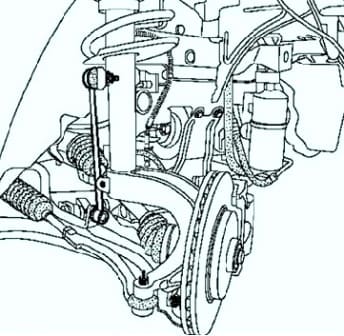
Remove the ball joint (fig. 4).
Disconnect the wheel drive shaft from the steering knuckle.
Remove the left front wheel drive shaft.
Remove the transmission ECU harness holder and side booster.
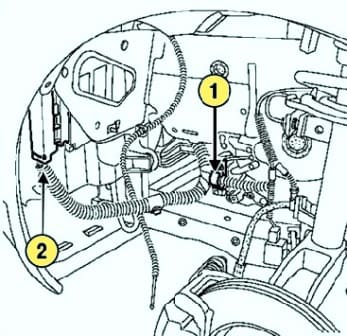
Open the transmission ECU harness lock and disconnect the transmission ECU connector (fig. 5).
Works carried out on the right side of the car:
Unscrew the hub nut using tool (Rou. 604-01).
Remove the tie rod end ball joint using tool (Tav. 476).
Remove the anti-roll bar ball joint using tool (Tav. 476).
Remove the ball joint.
Remove the intermediate support flange.

Disconnect the drive shaft from the steering knuckle (fig. 6).
Remove the right front wheel drive shaft.
Attach the engine cooling radiator assembly with condenser to the top cross member with twine.
Remove the side reinforcement.

Remove the lower radiator cross member (fig. 7).
With K4M engine

Remove the nuts securing the exhaust pipe and remove the tie rod (Fig. 8).
With F4R engine
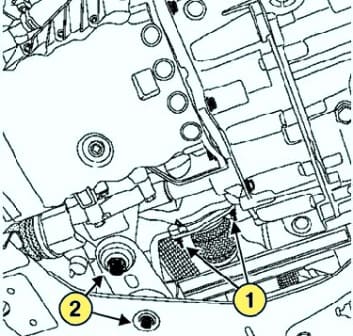
Remove the nuts securing the exhaust pipe and remove the tie rod (Fig. 9).
Remove the strut mounting the manifold to the bottom of the engine

Unscrew the mounting bolt and remove the starter (Fig. 10).
Unscrew the three torque converter mounting nuts.
Access to the torque converter fastening nuts opens after the starter is removed
Turn the crankshaft clockwise to access the three nuts connecting the drive plate to the torque converter.
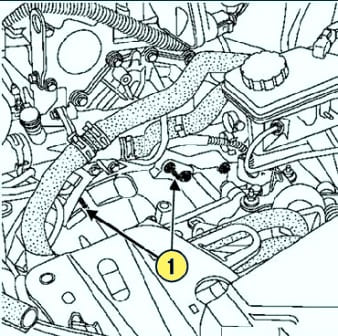
Remove the upper studs securing the gearbox housing to the engine block (Fig. 11).
Secure the hood with straps.
Remove the gearbox support pad.
Place the hydraulic jack under the gearbox.
Remove the lower bolts securing the gearbox to the engine block.
Remove the transmission studs.
Remove the automatic transmission.
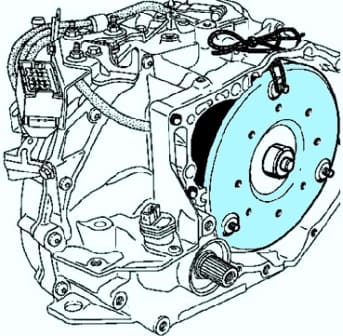
Secure the torque converter with a cord to prevent it from moving (fig. 12).
Installation
Do not re-use torque converter and drive plate mounting nuts, be sure to replace them with new ones.
Check for the presence of mounting sleeves.
Installation is performed in the reverse order of removal.
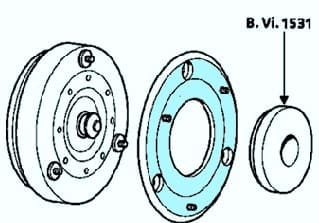
When installing an automatic transmission on the engine, make sure that the input shaft of the gearbox and the torque converter are aligned exactly (Fig. 13).
Torque tighten:
- - wheel bolts (110 Nm);
- - brake caliper guide pin bolts (7 Nm);
- - Tie rod end ball joint pin nut (37 Nm);
- - ball stud nut (62 Nm);
- - bolts for fastening the jet thrust to the subframe (105 Nm);
- - bolts for securing the gearbox and starter to the engine (44 Nm);
- - gearbox pendulum nut (62 Nm);
- - Tie rod end ball joint pin nut (62 Nm);
- - torque converter fastening nut on the drive disk (37 Nm);
- - modular jack bracket mounting bolts (20 Nm);
- - bolts for fastening the engine crankshaft speed sensor (10 Nm);
- - fastening bolts reactive thrust to the K4M engine (105 Nm);
- - bolts for fastening the jet thrust to the F4R engine (180 Nm);
- - the nut for attaching the pendulum support to the cushion (180 Nm).
Fill the oil in the automatic transmission and check its level.
In case of an oil change, reset the adaptive correction parameters using the command:
- RZ 005 "Reset self-tuning parameters" and reset the oil life counter in the automatic transmission computer by issuing command: CF074 "Recording the date of oil change in the gearbox".
After executing command RZ005, be sure to drive up and down several times to memorize the new settings.










